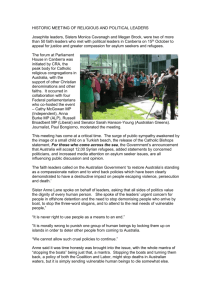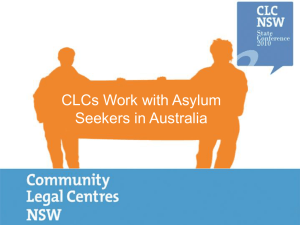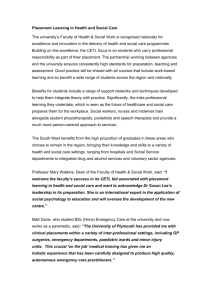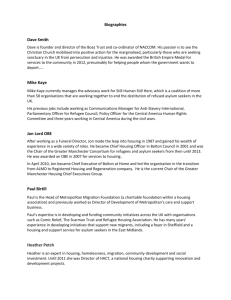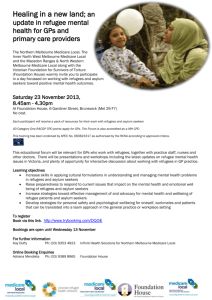Myths and Facts about Asylum Seekers
advertisement
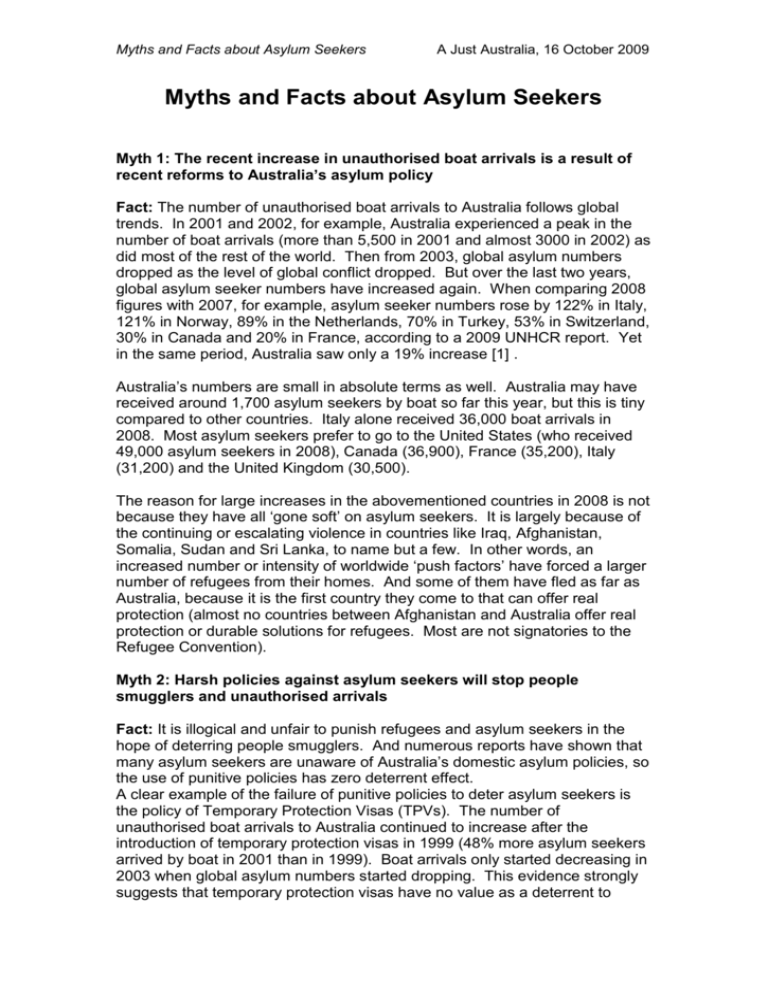
Myths and Facts about Asylum Seekers A Just Australia, 16 October 2009 Myths and Facts about Asylum Seekers Myth 1: The recent increase in unauthorised boat arrivals is a result of recent reforms to Australia’s asylum policy Fact: The number of unauthorised boat arrivals to Australia follows global trends. In 2001 and 2002, for example, Australia experienced a peak in the number of boat arrivals (more than 5,500 in 2001 and almost 3000 in 2002) as did most of the rest of the world. Then from 2003, global asylum numbers dropped as the level of global conflict dropped. But over the last two years, global asylum seeker numbers have increased again. When comparing 2008 figures with 2007, for example, asylum seeker numbers rose by 122% in Italy, 121% in Norway, 89% in the Netherlands, 70% in Turkey, 53% in Switzerland, 30% in Canada and 20% in France, according to a 2009 UNHCR report. Yet in the same period, Australia saw only a 19% increase [1] . Australia’s numbers are small in absolute terms as well. Australia may have received around 1,700 asylum seekers by boat so far this year, but this is tiny compared to other countries. Italy alone received 36,000 boat arrivals in 2008. Most asylum seekers prefer to go to the United States (who received 49,000 asylum seekers in 2008), Canada (36,900), France (35,200), Italy (31,200) and the United Kingdom (30,500). The reason for large increases in the abovementioned countries in 2008 is not because they have all ‘gone soft’ on asylum seekers. It is largely because of the continuing or escalating violence in countries like Iraq, Afghanistan, Somalia, Sudan and Sri Lanka, to name but a few. In other words, an increased number or intensity of worldwide ‘push factors’ have forced a larger number of refugees from their homes. And some of them have fled as far as Australia, because it is the first country they come to that can offer real protection (almost no countries between Afghanistan and Australia offer real protection or durable solutions for refugees. Most are not signatories to the Refugee Convention). Myth 2: Harsh policies against asylum seekers will stop people smugglers and unauthorised arrivals Fact: It is illogical and unfair to punish refugees and asylum seekers in the hope of deterring people smugglers. And numerous reports have shown that many asylum seekers are unaware of Australia’s domestic asylum policies, so the use of punitive policies has zero deterrent effect. A clear example of the failure of punitive policies to deter asylum seekers is the policy of Temporary Protection Visas (TPVs). The number of unauthorised boat arrivals to Australia continued to increase after the introduction of temporary protection visas in 1999 (48% more asylum seekers arrived by boat in 2001 than in 1999). Boat arrivals only started decreasing in 2003 when global asylum numbers started dropping. This evidence strongly suggests that temporary protection visas have no value as a deterrent to Myths and Facts about Asylum Seekers A Just Australia, 16 October 2009 unauthorised boat arrivals. The same rationale holds true for mandatory detention, introduced in 1992. Refugees are often forced to flee horrendous situations such as genocide or torture. Desperate people will continue to take desperate measures to seek safety. The only way to stop unauthorised boat arrivals into Australia is to cooperate regionally and internationally to resolve conflicts and to create durable solutions for refugees so that they do not have to undertake perilous journeys to find safety. Myth 3: Refugees who get to Indonesia should stay there and not come to Australia Fact: Very few countries between the Middle East and Australia have signed the Refugee Convention. There is no real or permanent protection in these countries, so many asylum seekers have to continue to Australia before they get their first reasonable opportunity to apply for protection. Indonesia is not a signatory to the Refugee Convention and the Indonesian government does not offer real protection or durable solutions for refugees there. Firstly, asylum seekers are detained indefinitely in 'hugely overcrowded' detention centres in 'horrendous conditions', according to one Australian researcher. They are detained until their claim is finalised by the UNHCR office in Indonesia - a process which takes, on average, 10 years in Indonesia. Secondly, even when someone is registered by UNHCR as a refugee, they are not permitted to seek employment, send their children to school, apply for family reunion or apply for residency. Clearly, Indonesia is not yet at a stage where they can offer refugees their human rights. Myth 4: Boat people are ‘queue jumpers’, stealing the places of ‘genuine’ refugees waiting patiently in camps for their turn at orderly processing by the UNHCR Fact: The myth of a 'queue' - where refugees from around the world have their names recorded in an organised database and 'wait their turn' - is completely untrue. Many asylum seekers come from countries where there is no UNHCR office and no Australian embassy (e.g. Iraq or Afghanistan). Even in a country with a UNHCR office, a refugee may not physically be able to get there to register, perhaps because of roadblocks, curfews and travel restrictions. Sometimes, going to a UNHCR office and/or expressing a desire to leave may literally put your life at risk or expose you to a greater degree of danger. Sometimes refugees are prevented from registering for political reasons. In one instance reported by an Australian Federal MP in 2008, UNHCR was not allowed to register refugees from a certain country, as government officials did not wish to acknowledge that there was turmoil in that country [iii]. Many refugees will try to avoid taking refuge in a camp, as they don’t believe doing so will increase their chances of escape, or even survival. Conditions in Myths and Facts about Asylum Seekers A Just Australia, 16 October 2009 refugee camps have been frequently reported to be as dangerous as the situations from which people fled. And in many countries, Australian officials do not visit refugee camps to see if people have protection needs. Some people say that asylum seekers arriving by boat ‘steal’ the places of people who could come via the off-shore Humanitarian program. However, there is no logical basis for the concept of playing one type of refugee off against another, and no logical reason why these two separate pathways should be linked. Myth 5: Getting rid of Temporary Protection Visas (TPVs) sent a ‘green light’ to people smugglers. We should bring back TPVs. Fact: Hardliners within the Shadow Cabinet claim that the abolition of TPVs sent a ‘green light’ to people smugglers, but the statistics prove them wrong. The number of unauthorised boat arrivals to Australia continued to increase after the introduction of temporary protection visas in 1999 (48% more asylum seekers arrived by boat in 2001 than in 1999). Boat arrivals only started decreasing in 2003 when global asylum numbers started dropping. This evidence strongly suggests that temporary protection visas have no value as a deterrent to unauthorised boat arrivals. Or consider this: in 2005, the Howard government changed TPV laws so that people could apply for permanent visas after 30 months of being on a TPV, essentially relaxing their own TPV policy – yet there was no increase in boat numbers. And former Immigration Minister Phillip Ruddock repeatedly claimed that letting children out of detention centres would send a ‘green light’ to people smugglers. In 2005, in response to community concern, the Howard government let the children out – yet there was no increase in boat numbers. TPVs caused great hardship. Refugees who were granted TPVs were unable to apply for family reunion, get adequate settlement assistance or have the stability and security of permanent protection. TPVs even caused deaths. Many of the passengers of the SIEV X, for example, were the wives and children of TPV holders, attempting to reunite their families. The TPV policy was first put forward by Pauline Hanson. Phillip Ruddock at the time said “Can you imagine what temporary entry would mean for them? …I regard the One Nation’s approach as being highly unconscionable in a way that most thinking people would clearly reject”. Myth 6: Boat people are not ‘genuine’ refugees because they pay people smugglers Fact: Asylum seekers who use people smugglers are mostly desperate people whose options have run out. They see this route as the only way that they will gain safety for themselves and their families. Extended families may Myths and Facts about Asylum Seekers A Just Australia, 16 October 2009 sell everything they have, and live on tiny incomes for years, to send one person to safety. Many families end up with large debts to the smugglers. A study by the aid agency Medecins Sans Frontieres in refugee camps on the Iranian border, found that nearly all families were in debt, with members held hostage by smugglers until the debt was paid. One does not have to poor or uneducated to be a refugee. In fact, many people have experienced increased persecution because of their educational, professional or political backgrounds. Sometime even refugees in camps have to pay large bribes to processing officials to have their refugee claims assessed. Myth 7: People who arrive unauthorised are not ‘genuine’ refugees. They are illegal immigrants. Fact: Asylum seekers are not criminals or illegal immigrants. Under Australian and international law, a person is permitted to enter Australia for the purpose of seeking asylum, whether by boat or by air. A refugee’s claim for asylum has nothing to do with how they arrive in a country, but everything to do with the persecution that they are escaping. The idea of ‘deserving’ and ‘undeserving’ refugees has been promoted by some Australian politicians for their own political advantage. In order to justify ‘getting tough’ on unauthorised arrivals, these politicians have inaccurately labelled asylum seekers as ‘illegal’ and ‘not genuine’. However, the Department of Immigration and Citizenship’s figures indicate that 84% of those who arrive unauthorised in Australia seeking asylum are found to be refugees. There are people who can be classified as illegal immigrants. These are people who overstay their visas (at any one time there are about 50,000 overstayers in the country [iv]). Most of these are from western countries, particularly the US or UK, and are not seeking asylum in Australia. Myth 8: If we abolish mandatory detention we will ‘open the floodgates’ and be ‘swamped’ by unauthorised arrivals Fact: There is no evidence to suggest that mandatory detention is a deterrent to boat arrivals. Australia has had a mandatory detention policy since 1992, and since then there have been increases in asylum seeker arrivals, due to ‘push’ factors in source countries such as Afghanistan. The policy of mandatory detention of boat arrivals is inhumane and is in breach of international law as it is arbitrary, non-reviewable and discriminates against people for their mode of arrival regardless of the legitimacy of their claim. While Australia has the right to protect its borders and its security, it also has the responsibility to uphold its human rights obligations. The way in which we choose to treat vulnerable populations of our society, such as refugees and asylum seekers, speaks volumes about our values. Myths and Facts about Asylum Seekers A Just Australia, 16 October 2009 Myth 9: Without mandatory detention, boat arrivals are a health risk to the community Fact: An average of 1,180 people arrive in Australia every day (according to ABS figures measured between March 2007 and 2008) [2] . Most of these were tourists and were not required to have health checks, yet there is no evidence to suggest that asylum seekers and refugees are any less healthy than people travelling for tourism. In addition, the government does not detain asylum seekers who arrive by plane and allows them one to two months to get a health check, because the government knows that there is minimal risk to the community. There is no reason why asylum seekers who arrive by boat should be treated any differently, and DIAC has admitted that boat arrivals are no less healthy than other visitors to Australia [v]. Myth 10: Refugee advocates want unrestricted entry of refugees, which will allow terrorists into Australia Fact: No credible organisation who speaks on behalf of refugees advocates a policy of unrestricted entry. Australia does not allow, and has never allowed, unrestricted entry of any person. People who arrive without authorisation have their claims for asylum scrutinised at length. Most are found to be genuine refugees. There is zero evidence that any asylum seekers who have arrived in Australia by boat have connections to terrorism. In fact, in August 2002, the Director-General of ASIO told Parliament that of 5,986 boat arrivals, not one was found to be a security risk [vi]. Myth 11: Refugees have no right to come here and expect us to help them Fact: "Everyone has the right to seek and enjoy in other countries freedom from persecution" - Article 14, Universal Declaration of Human Rights Australians are lucky in that we are born in a country where human rights are respected. Unfortunately, others are not so lucky. But they still have the same human rights as we do and they have the right to seek safety in a country that upholds human rights. This does not mean that Australia alone must take the full burden for protecting the persecuted. It does mean that we have to play a part in an international response that includes a wide spectrum of initiatives from addressing root causes to providing asylum to people whose human rights have been violated. Myths and Facts about Asylum Seekers A Just Australia, 16 October 2009 Myth 12: Refugees are too “culturally different” to fit in with the Australian way of life Fact: That accusation has been levelled at just about every immigrant minority group since white settlement in Australia began, from the Irish and the Chinese, to Jewish refugees after WW2, Greeks, Italians and Vietnamese. All of those groups have settled successfully in Australia. The process has not always been smooth or easy, but compared with the strife and hatred elsewhere, Australian multiculturalism is a demonstrable success. In just one example, Afghanis have lived in Australia for over a century, and played an important role in the opening up of trade routes through some of the country’s most inhospitable areas. ______________________________________________________________ Acknowledgements Debunking the Myths about Asylum Seekers by The Edmund Rice Centre for Justice and Community Education and the School of Education, Australian Catholic University The Truth Hurts, by the Centre for Refugee Research at UNSW Examining Australia’s Asylum Seeker and Refugee Policies, by Researchers for Asylum Australia’s Unfair Shores, by Amnesty International Australia Long-term Immigration Detention and Children's Mental Health, by Dr Sev Ozdowski, Human Rights Commissioner, to the XXIV World Congress of OMEP, Melbourne 24 July 2004 References [i] UNHCR: Asylum levels and trends in industrialized countries 2008: Statistical Overview of Asylum Applications Lodged in Europe and selected Non-European Countries. 24 March 2009. [ii] Australian Bureau of Statistics – 24 September 2008. Net overseas migration to Australia highest on record: ABS (95/2008) [iii] Joint Standing Committee on Migration –24 September 2008 [iv] Joint Standing Committee on Migration –24 September 2008 [v] Joint Standing Committee on Foreign Affairs, Defence and Trade, Human Rights Subcommittee, 22 August 2002 [vi] Joint Standing Committee on Migration –24 October 2008
